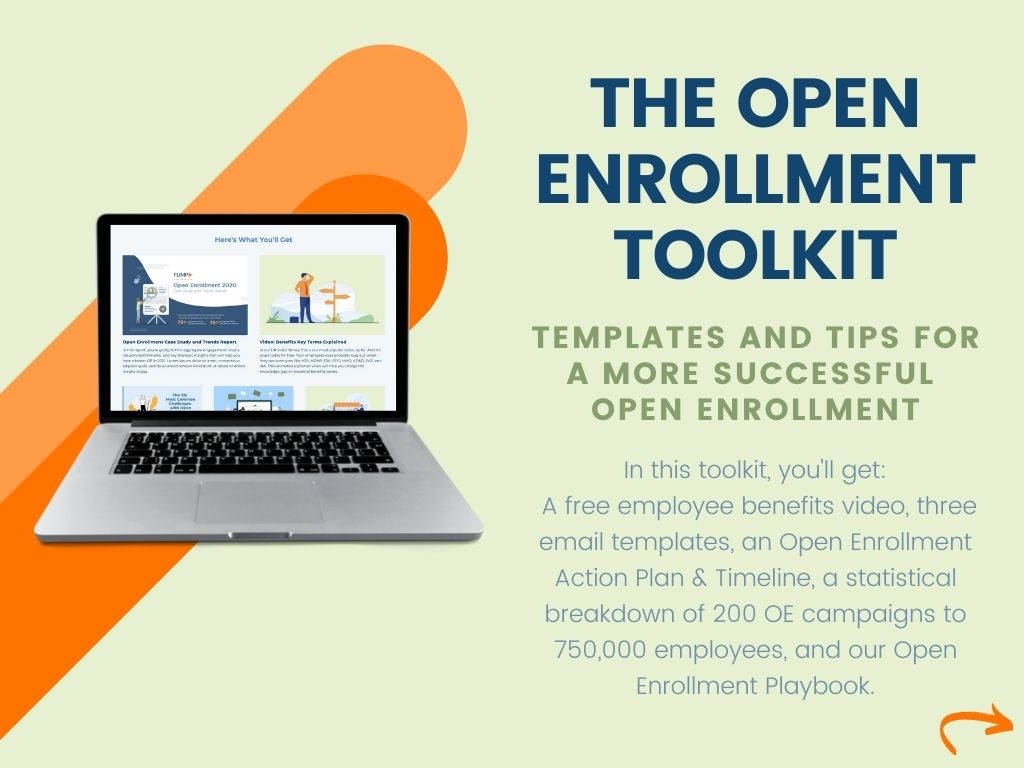It should come as no surprise that average attention spans are shrinking at an alarming rate. You’ve probably noticed in your own life that long emails, dense articles, and lengthy meetings try your patience much more than they used to. In our fast-paced digital age, there are simply too many distractions coming at us from all directions to focus on any one thing for too long.
(It’s not that our brains have changed. The screens are the problem, researchers say.)
So how can you communicate essential benefits information during open enrollment to employees whose attention spans are getting even shorter every year?
Open Enrollment: A Peek Inside the Employee Mind
If you’re reading this article and work in HR, you probably don’t need to be reminded that most employees view open enrollment as — at best — an annoying but necessary chore. (And at worst, your employees hate open enrollment.)
According to Aflac’s 2022-23 WorkForces Report (an annual survey of over 2,000 workers in various U.S. industries), nearly three out of five employees spend less than 30 minutes researching their benefits. And yet, only 43% of all employees are confident they fully understand their health insurance plans; only 58% say they are highly satisfied with their benefits.
This data paints the picture of the typical employee during open enrollment: Unable to grasp the differences between benefit options yet lacking the time or focus to learn about them, the employee throws up their hands and defaults to the same benefits year after year.
(According to the Aflac report, 89% of employees choose the same benefits each year.)
As an HR professional, this state of affairs is extremely frustrating. You know that many of your employees would save money or get better coverage with a change in health plans. Yet, instead of opting for HDHPs and other financially advantageous plans, too many employees continue to pay higher premiums for coverage they don’t need.
But what can you do with only a half-hour — maximum! — window of attention?
Quite a lot, actually. With the right mix of technology, communication strategies, and a deep understanding of human psychology, HR teams can not only adapt to this era of short attention spans but help employees make better-informed decisions than ever before.
Here are five effective open-enrollment communication tips tailored to reach employees with short attention spans:
1. Format Content for Scannability and Mobile Consumption
It’s disappointing, but it’s true; no matter how much useful information you pack into your emails and benefits guides, you cannot expect every employee to read every word. Eye-tracking studies have found that busy, distracted readers tend to scan textual content looking for “signposts” indicating key points.
As attention spans deteriorate, dense blocks of text present barriers to understanding, especially on smaller mobile screens (where the majority of content is consumed these days).
Here are a few ways to make your open enrollment content more scannable:
- Break the text up into sections with clearly defined subheads.
- List the contents at the top of pieces so readers can quickly find the information they need.
- Keep your paragraphs short, no more than three sentences per paragraph — less, if possible.
- Use bulleted or numbered lists to highlight essential information.
- Conclude with a list of takeaways, the most important points you want your employees to understand.
- Steer clear of jargon, and if you must use technical terms, define them.
- Use links to direct employees to deeper reading on particular topics.
Having a colleague look over any email or informational piece before distributing it is also a good idea. A fresh pair of eyes can often tell you where to cut the fat. Digital tools like the Hemingway Editor or AI tools like ChatGPT can also help you tighten up your writing.
(Here are three open enrollment email templates formatted for brevity and readability. Feel free to borrow as much as you need from them.)
2. Use Graphics to Make Plan Comparisons Easier
One reason employees despise researching benefits is that comparing plans one-to-one is so tricky. Providers use different metrics and language to describe their offerings, which forces employees to parse confusing plan documents and perform complex calculations to determine the differences between plans.
With a few well-designed charts and graphics, you can make this task much easier for employees. For example, a chart listing key plan details — deductible, premium, network type, out-of-pocket maximum, etc. — featured prominently in your benefits guide, would help employees differentiate their options at a glance.
Graphics such as bar graphs and pie charts can also help employees visualize plan differences.
3. Leverage Video Content to Demystify Complex Benefit Concepts
There’s a reason video apps and sites like YouTube and TikTok are top destinations not only for entertainment but also for how-tos, product reviews, and educational content. While text-based communication certainly has its merits, video excels at simplifying complex topics and holding the attention of distracted employees.
A well-produced video is dynamic and engaging, marrying text, visuals, and sound to connect with learners of all types.
Of course, this means that a video of you sitting at your desk and reading from a script will likely not captivate your employees any more than a long-winded email. But you don’t need to be a video production expert to provide watchable and informative explanatory video content during open enrollment.
For many, many benefits topics, the videos have already been created for you.
For example, Flimp offers a library of professionally produced videos featuring appealing animation, clear narration (in English or Spanish), and illuminating graphics. Our video library covers over 80 benefits-related topics, covering everything from how an HDHP works to managing stress and mental health.
Flimp’s video explainers are available to license individually or in bulk and can be customized with your company logo.
4. Personalize (and Accelerate) the Open Enrollment Experience With Data Analytics
Employees often face two equally unappealing choices during open enrollment: attempt to plot out their healthcare needs for the coming year (which is time-consuming and uncertain) or take a chance on a plan and hope for the best.
A third and better option is a decision-support tool, the most effective of which use powerful data analytics to help employees project their expenses and select the most appropriate plan in mere minutes.
How is this possible? It’s the power of massive datasets and advanced analytical algorithms. For example, PLANselect, a decision-support tool from Flimp, asks users a few simple, non-intrusive questions and then weighs their answers against a database of over 300 million healthcare claimants.
By comparing your employees to others with similar needs, PLANselect can accurately predict their healthcare spending. Plan options are presented in a straightforward, personalized comparison table that clearly indicates the best-value option based on each employee’s specific needs.
With a data-driven decision-support tool like PLANselect, open enrollment can be completed in as few as five minutes. Employees appreciate the intuitive, mobile-friendly interface and trustworthy results, while HR teams love the 20% to 25% increase in HDHP plan migration.
5. Plan a Year-Round Communications Strategy
One last tip for communicating with short-attention-span employees during open enrollment: Don’t just communicate with them during open enrollment! Release helpful benefits information in digestible bites year-round.
Think about the difference between cramming for an exam and keeping up with a class throughout the semester. A steady drip of information almost always leads to better retention than a one-time info dump.
Plus, the open enrollment period tends to fall at a hectic time of year for business and your employees’ personal lives. School is just getting underway, the holiday season is around the corner, and the end of the fiscal year is imminent.
It’s hardly what you would call a distraction-free environment. Other times during the year may provide the relative calm employees need to focus on benefits information.
Read our recent article for tips on planning a year-round benefits communication strategy, and get your free year-round benefits communication calendar here.
You Can’t Fix Short Attention Spans; You Can Adapt Your Communication Strategy
Along with the rest of America, your employee’s attention spans are undoubtedly on a downward trajectory, and there’s not much you can do about it. But it doesn’t have to spell doom for your open enrollment outreach efforts.
Using technology and a modern understanding of human behavior to your advantage, you can adapt to your employees’ distractedness and guide them toward smarter decisions.

